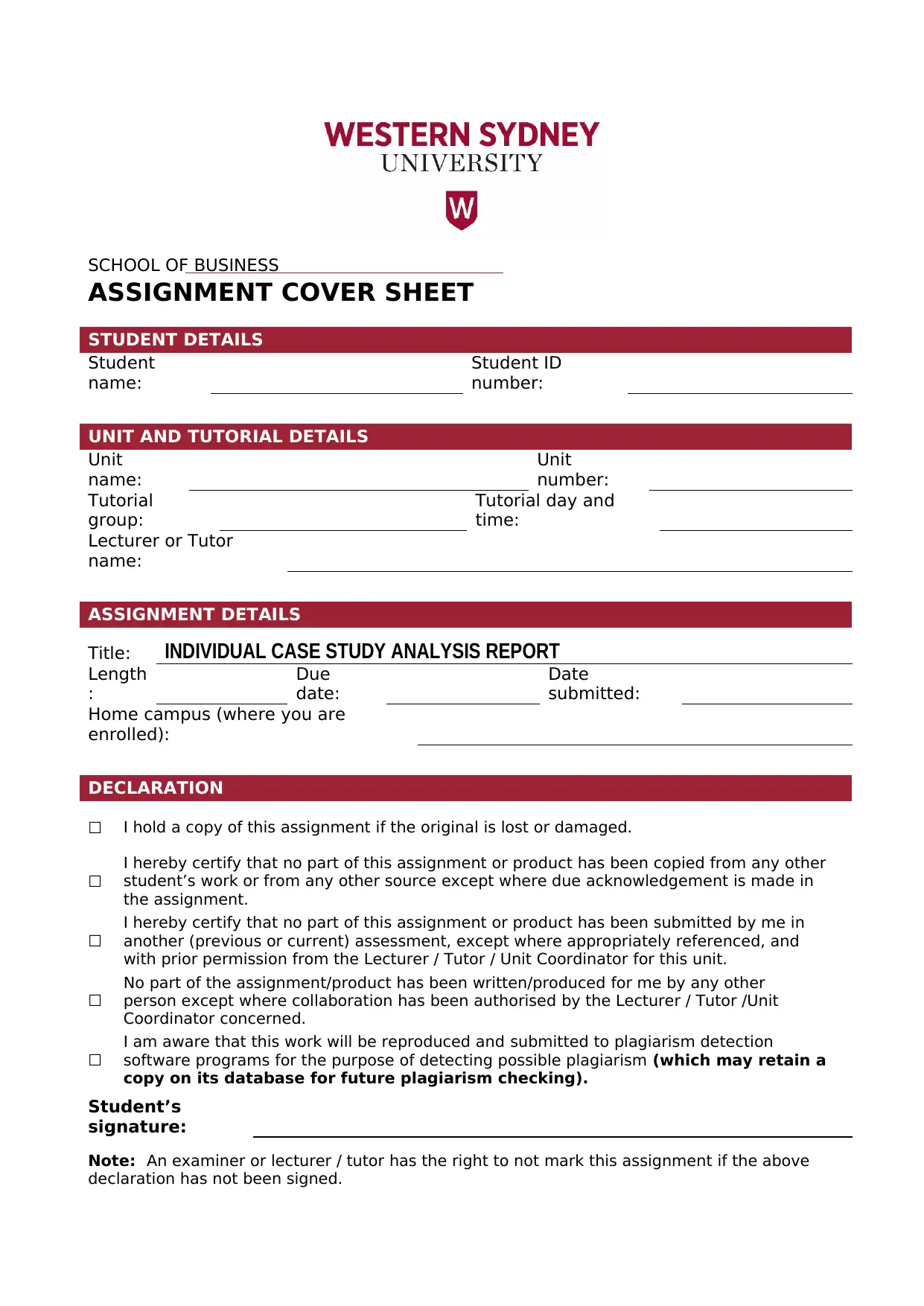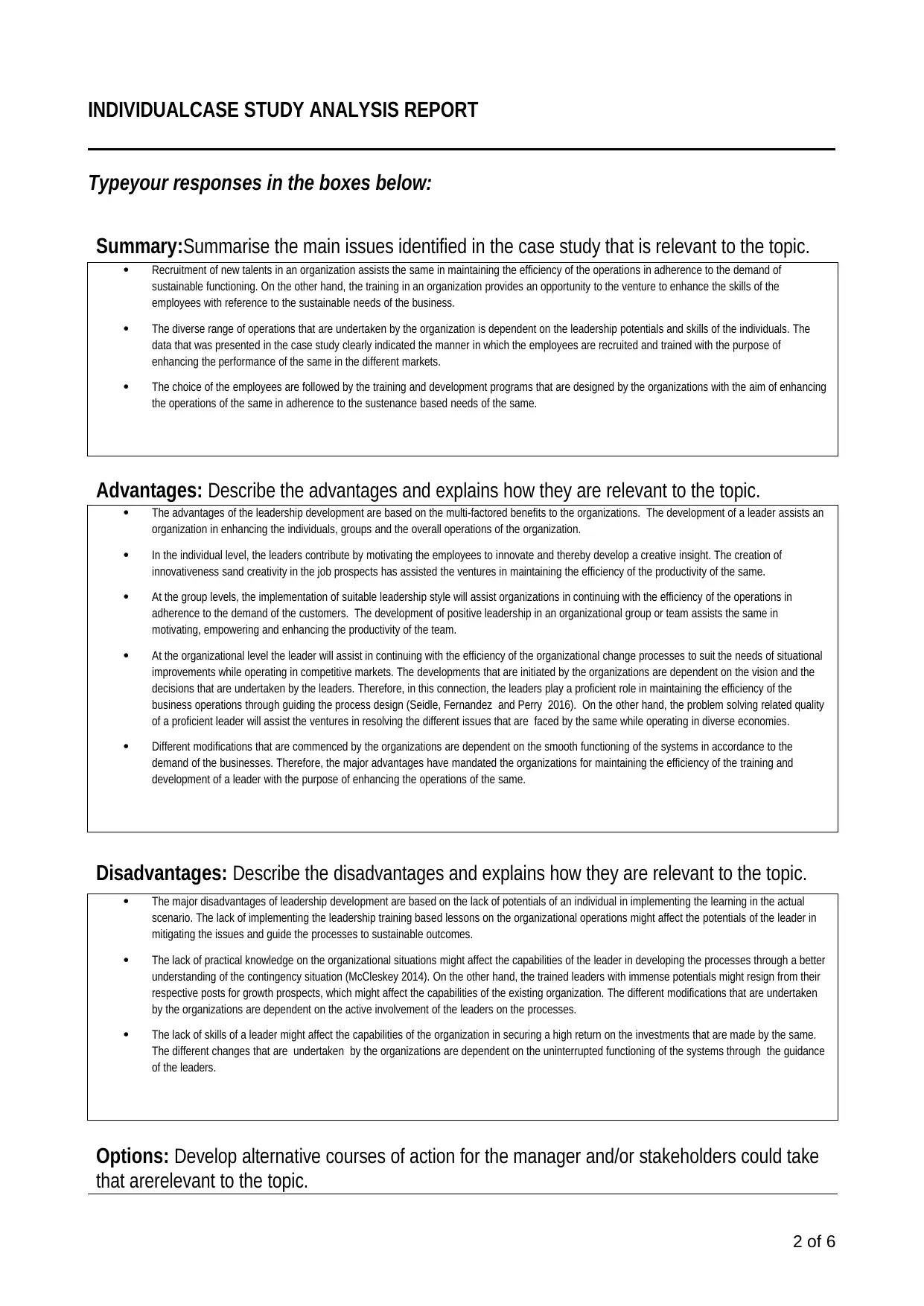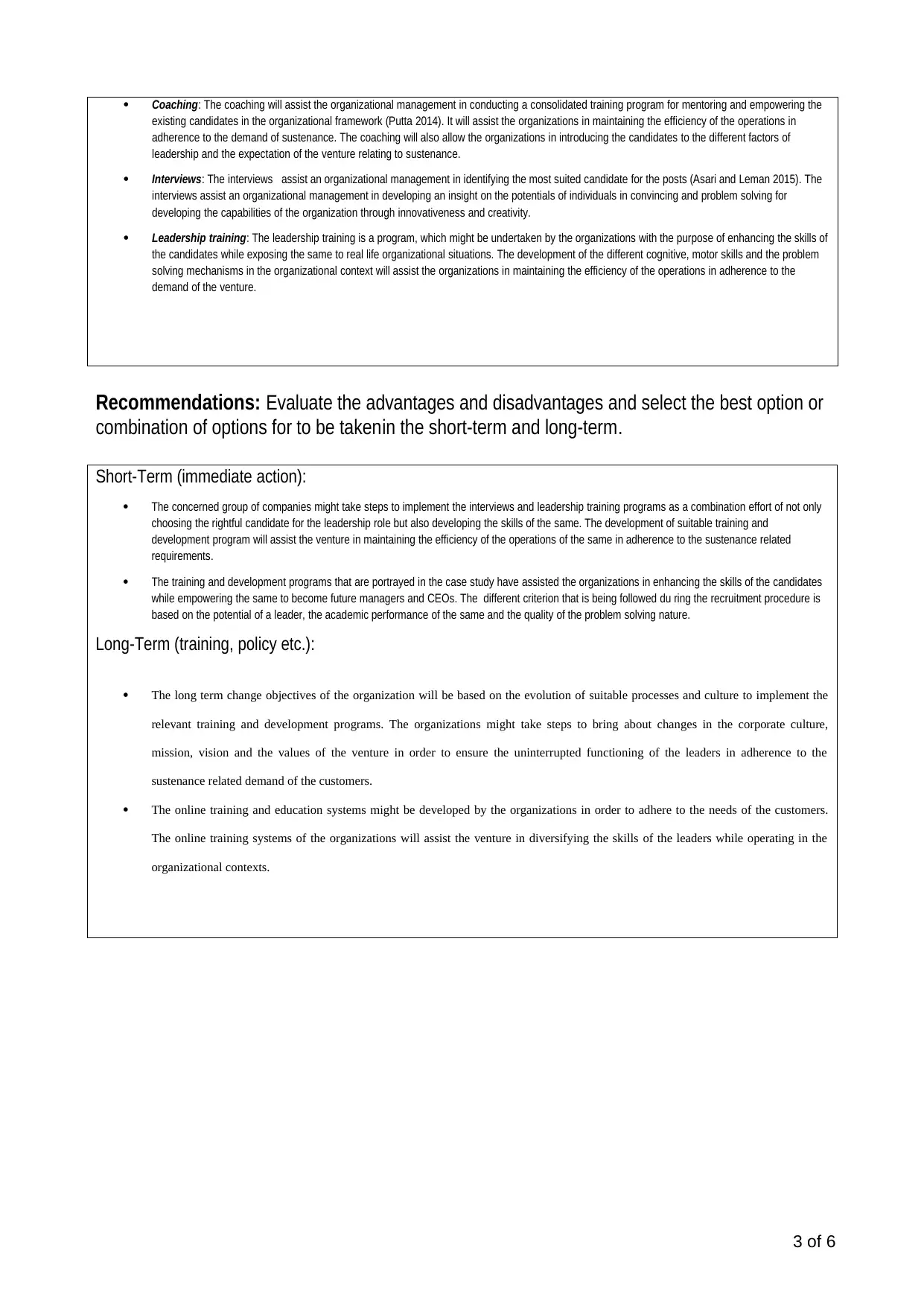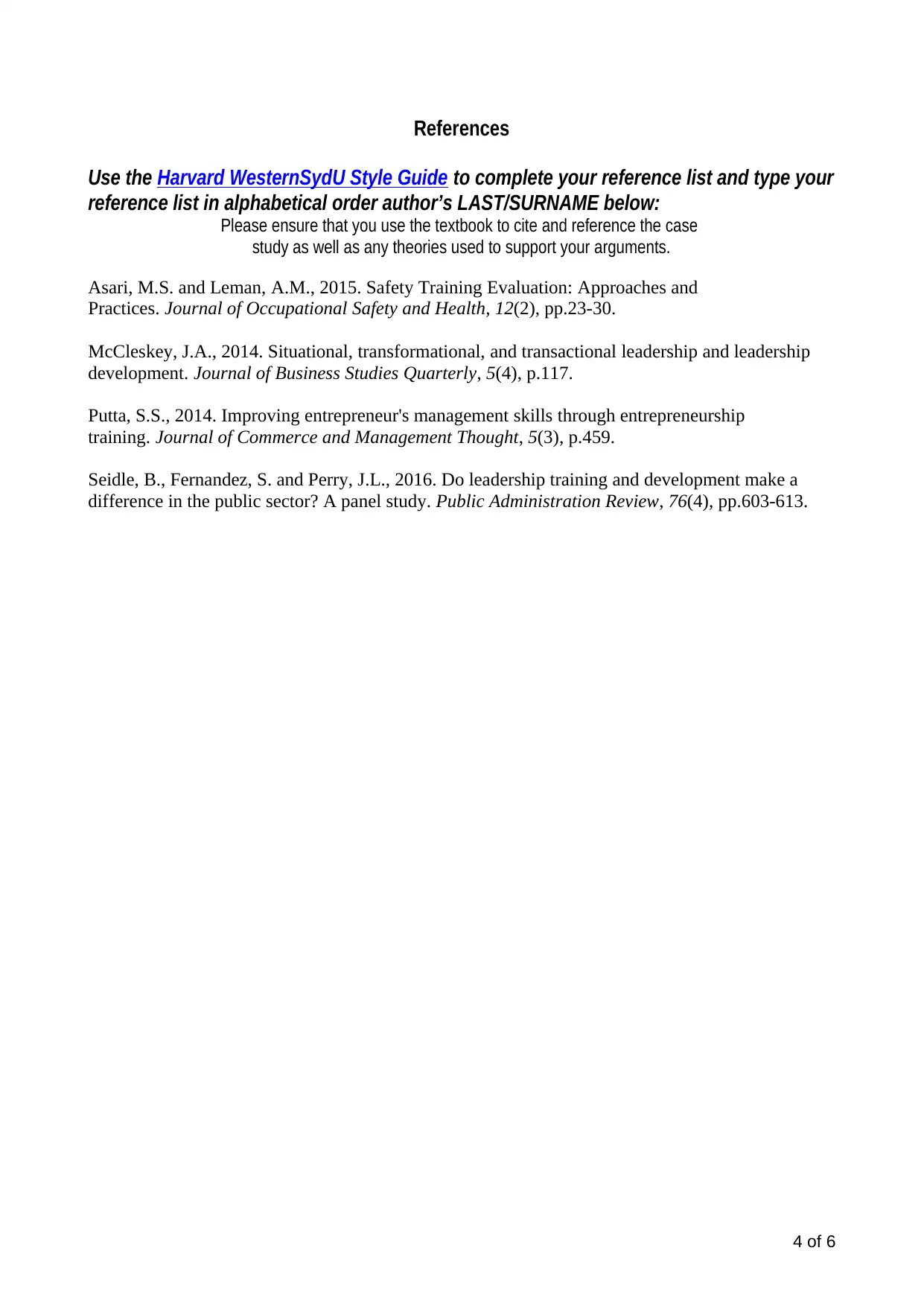Organisational Behaviour: Leadership Case Study Analysis Report
VerifiedAdded on 2022/11/24
|5
|1717
|497
Case Study
AI Summary
This case study analysis examines the 'Leadership Factories' case, focusing on leadership development and its impact on organizational success. The analysis identifies the importance of recruiting and training new talents, and highlights the advantages of leadership development, such as fostering innovation and improving operational efficiency at individual, group, and organizational levels. It also acknowledges the disadvantages, including potential lack of practical implementation and employee turnover. Alternative courses of action, such as coaching, interviews, and leadership training programs, are explored. The report recommends a combination of interviews and leadership training in the short-term and the evolution of suitable processes and culture to implement the relevant training and development programs in the long-term. The analysis emphasizes the need for continuous improvement and adaptation to meet customer demands.

SCHOOL OF BUSINESS
ASSIGNMENT COVER SHEET
STUDENT DETAILS
Student
name:
Student ID
number:
UNIT AND TUTORIAL DETAILS
Unit
name:
Unit
number:
Tutorial
group:
Tutorial day and
time:
Lecturer or Tutor
name:
ASSIGNMENT DETAILS
Title: INDIVIDUAL CASE STUDY ANALYSIS REPORT
Length
:
Due
date:
Date
submitted:
Home campus (where you are
enrolled):
DECLARATION
☐ I hold a copy of this assignment if the original is lost or damaged.
☐
I hereby certify that no part of this assignment or product has been copied from any other
student’s work or from any other source except where due acknowledgement is made in
the assignment.
☐
I hereby certify that no part of this assignment or product has been submitted by me in
another (previous or current) assessment, except where appropriately referenced, and
with prior permission from the Lecturer / Tutor / Unit Coordinator for this unit.
☐
No part of the assignment/product has been written/produced for me by any other
person except where collaboration has been authorised by the Lecturer / Tutor /Unit
Coordinator concerned.
☐
I am aware that this work will be reproduced and submitted to plagiarism detection
software programs for the purpose of detecting possible plagiarism (which may retain a
copy on its database for future plagiarism checking).
Student’s
signature:
Note: An examiner or lecturer / tutor has the right to not mark this assignment if the above
declaration has not been signed.
ASSIGNMENT COVER SHEET
STUDENT DETAILS
Student
name:
Student ID
number:
UNIT AND TUTORIAL DETAILS
Unit
name:
Unit
number:
Tutorial
group:
Tutorial day and
time:
Lecturer or Tutor
name:
ASSIGNMENT DETAILS
Title: INDIVIDUAL CASE STUDY ANALYSIS REPORT
Length
:
Due
date:
Date
submitted:
Home campus (where you are
enrolled):
DECLARATION
☐ I hold a copy of this assignment if the original is lost or damaged.
☐
I hereby certify that no part of this assignment or product has been copied from any other
student’s work or from any other source except where due acknowledgement is made in
the assignment.
☐
I hereby certify that no part of this assignment or product has been submitted by me in
another (previous or current) assessment, except where appropriately referenced, and
with prior permission from the Lecturer / Tutor / Unit Coordinator for this unit.
☐
No part of the assignment/product has been written/produced for me by any other
person except where collaboration has been authorised by the Lecturer / Tutor /Unit
Coordinator concerned.
☐
I am aware that this work will be reproduced and submitted to plagiarism detection
software programs for the purpose of detecting possible plagiarism (which may retain a
copy on its database for future plagiarism checking).
Student’s
signature:
Note: An examiner or lecturer / tutor has the right to not mark this assignment if the above
declaration has not been signed.
Paraphrase This Document
Need a fresh take? Get an instant paraphrase of this document with our AI Paraphraser

2 of 6

INDIVIDUALCASE STUDY ANALYSIS REPORT
Typeyour responses in the boxes below:
Summary:Summarise the main issues identified in the case study that is relevant to the topic.
Recruitment of new talents in an organization assists the same in maintaining the efficiency of the operations in adherence to the demand of
sustainable functioning. On the other hand, the training in an organization provides an opportunity to the venture to enhance the skills of the
employees with reference to the sustainable needs of the business.
The diverse range of operations that are undertaken by the organization is dependent on the leadership potentials and skills of the individuals. The
data that was presented in the case study clearly indicated the manner in which the employees are recruited and trained with the purpose of
enhancing the performance of the same in the different markets.
The choice of the employees are followed by the training and development programs that are designed by the organizations with the aim of enhancing
the operations of the same in adherence to the sustenance based needs of the same.
Advantages: Describe the advantages and explains how they are relevant to the topic.
The advantages of the leadership development are based on the multi-factored benefits to the organizations. The development of a leader assists an
organization in enhancing the individuals, groups and the overall operations of the organization.
In the individual level, the leaders contribute by motivating the employees to innovate and thereby develop a creative insight. The creation of
innovativeness sand creativity in the job prospects has assisted the ventures in maintaining the efficiency of the productivity of the same.
At the group levels, the implementation of suitable leadership style will assist organizations in continuing with the efficiency of the operations in
adherence to the demand of the customers. The development of positive leadership in an organizational group or team assists the same in
motivating, empowering and enhancing the productivity of the team.
At the organizational level the leader will assist in continuing with the efficiency of the organizational change processes to suit the needs of situational
improvements while operating in competitive markets. The developments that are initiated by the organizations are dependent on the vision and the
decisions that are undertaken by the leaders. Therefore, in this connection, the leaders play a proficient role in maintaining the efficiency of the
business operations through guiding the process design (Seidle, Fernandez and Perry 2016). On the other hand, the problem solving related quality
of a proficient leader will assist the ventures in resolving the different issues that are faced by the same while operating in diverse economies.
Different modifications that are commenced by the organizations are dependent on the smooth functioning of the systems in accordance to the
demand of the businesses. Therefore, the major advantages have mandated the organizations for maintaining the efficiency of the training and
development of a leader with the purpose of enhancing the operations of the same.
Disadvantages: Describe the disadvantages and explains how they are relevant to the topic.
The major disadvantages of leadership development are based on the lack of potentials of an individual in implementing the learning in the actual
scenario. The lack of implementing the leadership training based lessons on the organizational operations might affect the potentials of the leader in
mitigating the issues and guide the processes to sustainable outcomes.
The lack of practical knowledge on the organizational situations might affect the capabilities of the leader in developing the processes through a better
understanding of the contingency situation (McCleskey 2014). On the other hand, the trained leaders with immense potentials might resign from their
respective posts for growth prospects, which might affect the capabilities of the existing organization. The different modifications that are undertaken
by the organizations are dependent on the active involvement of the leaders on the processes.
The lack of skills of a leader might affect the capabilities of the organization in securing a high return on the investments that are made by the same.
The different changes that are undertaken by the organizations are dependent on the uninterrupted functioning of the systems through the guidance
of the leaders.
Options: Develop alternative courses of action for the manager and/or stakeholders could take
that arerelevant to the topic.
2 of 6
Typeyour responses in the boxes below:
Summary:Summarise the main issues identified in the case study that is relevant to the topic.
Recruitment of new talents in an organization assists the same in maintaining the efficiency of the operations in adherence to the demand of
sustainable functioning. On the other hand, the training in an organization provides an opportunity to the venture to enhance the skills of the
employees with reference to the sustainable needs of the business.
The diverse range of operations that are undertaken by the organization is dependent on the leadership potentials and skills of the individuals. The
data that was presented in the case study clearly indicated the manner in which the employees are recruited and trained with the purpose of
enhancing the performance of the same in the different markets.
The choice of the employees are followed by the training and development programs that are designed by the organizations with the aim of enhancing
the operations of the same in adherence to the sustenance based needs of the same.
Advantages: Describe the advantages and explains how they are relevant to the topic.
The advantages of the leadership development are based on the multi-factored benefits to the organizations. The development of a leader assists an
organization in enhancing the individuals, groups and the overall operations of the organization.
In the individual level, the leaders contribute by motivating the employees to innovate and thereby develop a creative insight. The creation of
innovativeness sand creativity in the job prospects has assisted the ventures in maintaining the efficiency of the productivity of the same.
At the group levels, the implementation of suitable leadership style will assist organizations in continuing with the efficiency of the operations in
adherence to the demand of the customers. The development of positive leadership in an organizational group or team assists the same in
motivating, empowering and enhancing the productivity of the team.
At the organizational level the leader will assist in continuing with the efficiency of the organizational change processes to suit the needs of situational
improvements while operating in competitive markets. The developments that are initiated by the organizations are dependent on the vision and the
decisions that are undertaken by the leaders. Therefore, in this connection, the leaders play a proficient role in maintaining the efficiency of the
business operations through guiding the process design (Seidle, Fernandez and Perry 2016). On the other hand, the problem solving related quality
of a proficient leader will assist the ventures in resolving the different issues that are faced by the same while operating in diverse economies.
Different modifications that are commenced by the organizations are dependent on the smooth functioning of the systems in accordance to the
demand of the businesses. Therefore, the major advantages have mandated the organizations for maintaining the efficiency of the training and
development of a leader with the purpose of enhancing the operations of the same.
Disadvantages: Describe the disadvantages and explains how they are relevant to the topic.
The major disadvantages of leadership development are based on the lack of potentials of an individual in implementing the learning in the actual
scenario. The lack of implementing the leadership training based lessons on the organizational operations might affect the potentials of the leader in
mitigating the issues and guide the processes to sustainable outcomes.
The lack of practical knowledge on the organizational situations might affect the capabilities of the leader in developing the processes through a better
understanding of the contingency situation (McCleskey 2014). On the other hand, the trained leaders with immense potentials might resign from their
respective posts for growth prospects, which might affect the capabilities of the existing organization. The different modifications that are undertaken
by the organizations are dependent on the active involvement of the leaders on the processes.
The lack of skills of a leader might affect the capabilities of the organization in securing a high return on the investments that are made by the same.
The different changes that are undertaken by the organizations are dependent on the uninterrupted functioning of the systems through the guidance
of the leaders.
Options: Develop alternative courses of action for the manager and/or stakeholders could take
that arerelevant to the topic.
2 of 6
⊘ This is a preview!⊘
Do you want full access?
Subscribe today to unlock all pages.

Trusted by 1+ million students worldwide

Coaching: The coaching will assist the organizational management in conducting a consolidated training program for mentoring and empowering the
existing candidates in the organizational framework (Putta 2014). It will assist the organizations in maintaining the efficiency of the operations in
adherence to the demand of sustenance. The coaching will also allow the organizations in introducing the candidates to the different factors of
leadership and the expectation of the venture relating to sustenance.
Interviews: The interviews assist an organizational management in identifying the most suited candidate for the posts (Asari and Leman 2015). The
interviews assist an organizational management in developing an insight on the potentials of individuals in convincing and problem solving for
developing the capabilities of the organization through innovativeness and creativity.
Leadership training: The leadership training is a program, which might be undertaken by the organizations with the purpose of enhancing the skills of
the candidates while exposing the same to real life organizational situations. The development of the different cognitive, motor skills and the problem
solving mechanisms in the organizational context will assist the organizations in maintaining the efficiency of the operations in adherence to the
demand of the venture.
Recommendations: Evaluate the advantages and disadvantages and select the best option or
combination of options for to be takenin the short-term and long-term.
Short-Term (immediate action):
The concerned group of companies might take steps to implement the interviews and leadership training programs as a combination effort of not only
choosing the rightful candidate for the leadership role but also developing the skills of the same. The development of suitable training and
development program will assist the venture in maintaining the efficiency of the operations of the same in adherence to the sustenance related
requirements.
The training and development programs that are portrayed in the case study have assisted the organizations in enhancing the skills of the candidates
while empowering the same to become future managers and CEOs. The different criterion that is being followed du ring the recruitment procedure is
based on the potential of a leader, the academic performance of the same and the quality of the problem solving nature.
Long-Term (training, policy etc.):
The long term change objectives of the organization will be based on the evolution of suitable processes and culture to implement the
relevant training and development programs. The organizations might take steps to bring about changes in the corporate culture,
mission, vision and the values of the venture in order to ensure the uninterrupted functioning of the leaders in adherence to the
sustenance related demand of the customers.
The online training and education systems might be developed by the organizations in order to adhere to the needs of the customers.
The online training systems of the organizations will assist the venture in diversifying the skills of the leaders while operating in the
organizational contexts.
3 of 6
existing candidates in the organizational framework (Putta 2014). It will assist the organizations in maintaining the efficiency of the operations in
adherence to the demand of sustenance. The coaching will also allow the organizations in introducing the candidates to the different factors of
leadership and the expectation of the venture relating to sustenance.
Interviews: The interviews assist an organizational management in identifying the most suited candidate for the posts (Asari and Leman 2015). The
interviews assist an organizational management in developing an insight on the potentials of individuals in convincing and problem solving for
developing the capabilities of the organization through innovativeness and creativity.
Leadership training: The leadership training is a program, which might be undertaken by the organizations with the purpose of enhancing the skills of
the candidates while exposing the same to real life organizational situations. The development of the different cognitive, motor skills and the problem
solving mechanisms in the organizational context will assist the organizations in maintaining the efficiency of the operations in adherence to the
demand of the venture.
Recommendations: Evaluate the advantages and disadvantages and select the best option or
combination of options for to be takenin the short-term and long-term.
Short-Term (immediate action):
The concerned group of companies might take steps to implement the interviews and leadership training programs as a combination effort of not only
choosing the rightful candidate for the leadership role but also developing the skills of the same. The development of suitable training and
development program will assist the venture in maintaining the efficiency of the operations of the same in adherence to the sustenance related
requirements.
The training and development programs that are portrayed in the case study have assisted the organizations in enhancing the skills of the candidates
while empowering the same to become future managers and CEOs. The different criterion that is being followed du ring the recruitment procedure is
based on the potential of a leader, the academic performance of the same and the quality of the problem solving nature.
Long-Term (training, policy etc.):
The long term change objectives of the organization will be based on the evolution of suitable processes and culture to implement the
relevant training and development programs. The organizations might take steps to bring about changes in the corporate culture,
mission, vision and the values of the venture in order to ensure the uninterrupted functioning of the leaders in adherence to the
sustenance related demand of the customers.
The online training and education systems might be developed by the organizations in order to adhere to the needs of the customers.
The online training systems of the organizations will assist the venture in diversifying the skills of the leaders while operating in the
organizational contexts.
3 of 6
Paraphrase This Document
Need a fresh take? Get an instant paraphrase of this document with our AI Paraphraser

References
Use the Harvard WesternSydU Style Guide to complete your reference list and type your
reference list in alphabetical order author’s LAST/SURNAME below:
Please ensure that you use the textbook to cite and reference the case
study as well as any theories used to support your arguments.
Asari, M.S. and Leman, A.M., 2015. Safety Training Evaluation: Approaches and
Practices. Journal of Occupational Safety and Health, 12(2), pp.23-30.
McCleskey, J.A., 2014. Situational, transformational, and transactional leadership and leadership
development. Journal of Business Studies Quarterly, 5(4), p.117.
Putta, S.S., 2014. Improving entrepreneur's management skills through entrepreneurship
training. Journal of Commerce and Management Thought, 5(3), p.459.
Seidle, B., Fernandez, S. and Perry, J.L., 2016. Do leadership training and development make a
difference in the public sector? A panel study. Public Administration Review, 76(4), pp.603-613.
4 of 6
Use the Harvard WesternSydU Style Guide to complete your reference list and type your
reference list in alphabetical order author’s LAST/SURNAME below:
Please ensure that you use the textbook to cite and reference the case
study as well as any theories used to support your arguments.
Asari, M.S. and Leman, A.M., 2015. Safety Training Evaluation: Approaches and
Practices. Journal of Occupational Safety and Health, 12(2), pp.23-30.
McCleskey, J.A., 2014. Situational, transformational, and transactional leadership and leadership
development. Journal of Business Studies Quarterly, 5(4), p.117.
Putta, S.S., 2014. Improving entrepreneur's management skills through entrepreneurship
training. Journal of Commerce and Management Thought, 5(3), p.459.
Seidle, B., Fernandez, S. and Perry, J.L., 2016. Do leadership training and development make a
difference in the public sector? A panel study. Public Administration Review, 76(4), pp.603-613.
4 of 6
1 out of 5
Related Documents
Your All-in-One AI-Powered Toolkit for Academic Success.
+13062052269
info@desklib.com
Available 24*7 on WhatsApp / Email
![[object Object]](/_next/static/media/star-bottom.7253800d.svg)
Unlock your academic potential
Copyright © 2020–2025 A2Z Services. All Rights Reserved. Developed and managed by ZUCOL.





